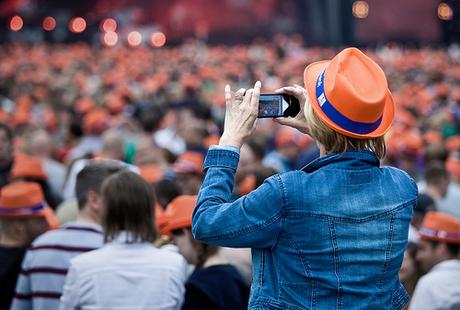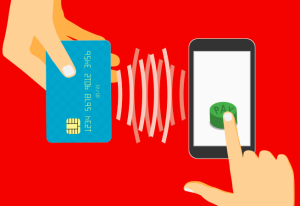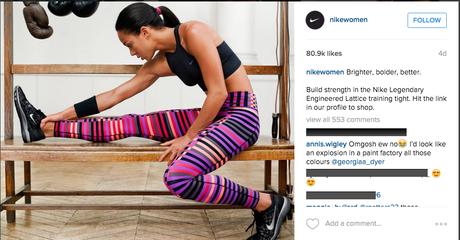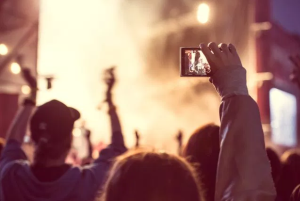 We inch closer to the end of the year, and my brain is still in April. Or at most, July. Yet here we are, closing one year and getting ready to kick off another one. Where does time go? Hopefully you’re enjoying this season and excited about all the promise that a new year brings. I know I am. With that, here’s the latest edition of “Things You Need To Know This Week.”
We inch closer to the end of the year, and my brain is still in April. Or at most, July. Yet here we are, closing one year and getting ready to kick off another one. Where does time go? Hopefully you’re enjoying this season and excited about all the promise that a new year brings. I know I am. With that, here’s the latest edition of “Things You Need To Know This Week.”
Cyber Security Has Become a Top Priority for Marketers
CNBC, MindMover, and Lightspeed GMI surveyed more than 500 business executives in the U.S., Europe, and Asia-Pacific and found that cyber security is a top concern. Zero surprises there – I write about that all the time.
More than 50 percent of U.S. respondents said cyber security will be a leading technology priority over the next 12 months, and 41 percent of European executives said it was a priority for them as well. It’s a great time to be an IT pro with a focus on security, that’s for sure.
The CNBC survey is in line with other data showing widespread concern about security among executives. April 2015 research by PricewaterhouseCoopers (PwC) found that in the U.S., cyber threats, including lack of data security was an area of “extreme concern” among 45% of U.S. CEOs. It’s clear that getting their arms around cloud technology, BYOD, compliance, and preparing in advance for a cyber attack instead of defending against one is where these folks are focusing in the coming year.

via Marketing Land
Cyber Monday Online Sales Set New Record with $3 Billion
Online sales topped $3 billion on Cyber Monday, according to Adobe. According to the company, 200 million visits to 4,500 retail websites generated $3.07 billion, an increase of 16 percent from a year ago. That makes it the biggest day of online sales in U.S. history.
More than a quarter of those sales (26 percent) came from mobile devices, generating $799 million in sales. Apple iOS devices drove $575 million of mobile sales while Android devices drove $219 million in mobile sales.
A couple of other interesting points from the Adobe data: Display ads drove 57 percent more sales compared to Cyber Monday last year. Social’s share of sales increased 33 percent year-over-year, with a big after-work spike at 6:00pm.
Looking at time-of day trends holistically, ChannelAdvisor says the traffic surge on Cyber Monday started between 5:00 and 6:00am ET and continued upward until peaking between 2:00 and 3:00pm. After leveling off throughout the afternoon, traffic began climbing again at 6:00pm until 11:00pm ET.
I shopped a little on Cyber Monday—and in the days before an after, as many retailers extended their sales both before and after. I made some purchases from my phone, but many more from my desktop. I also found that if I forgot to buy something when I looked it on Cyber Monday at an attractive, low price, and then went back to it (probably due to an open browser tab) and the retail price was significantly higher, I just decided I’d live without it. I’ve yet to walk into a store to buy any holiday gifts—what about you?
Advertising
Programmatic Ad Spending on Local TV Not Popular With Ad Agencies
According to November 2015 research by Strata, in excess of 66 percent of U.S. ad agency professionals said they will allocate no programmatic ad spending to local television, including spot and cable TV.
While more marketers are advertising programmatically, it’ still the early days for TV. More marketers are advertising programmatically on mobile and the desktop, with video along with other display formats, including social media and native. This is a wide range of popular digital ad formats, and real-time bidding and other programmatic buying methods have been available for longer.
Back in February, research by RBC Capital Markets and Advertising Age found that just 8 percent of marketers see the best opportunity for programmatic advertising on TV. One-third said that mobile presents the best opportunity for programmatic advertising and just 20 percent said they saw the most opportunity with video. This will be interesting to watch for sure.
Digital Video
Digital Viewers Likely to Multitask When Watching Live TV
TiVo surveyed U.S. adult digital video viewers and found 53 percent of respondents said they were most likely to multitask while watching live television while 28 percent of U.S. said they were most likely to multitask while watching time-shifted TV. Nineteen percent said they would most likely multitask while watching OTT or streamed content, such as Netflix and Hulu. I multi-task whether watching live or time-shifted – how about you?
In no news to anyone, commercials were most likely the reason more digital video viewers multitask while watching TV. Netflix doesn’t have commercials, but other streamed content, like Hulu, does. I really don’t think it matters—I think we are multitaskers in general, and more so every day. What about you?
A separate August 2014 survey found only 5 percent of respondents never or rarely multitasked during commercial breaks. In comparison, more than 55 percent said they multitask almost every time there is a commercial break.
Mobile
Most Digital Travel Bookers Will Use Mobile Devices by Next Year
eMarketer estimates that in 2016, almost 52 percent of travelers booking trips via digital methods will do so using a mobile device, representing an increase just shy of 44 percent over 2015.

There’s a reason for this, of course. The travel industry is paying attention and has been at the fore of adapting for consumers’ use of mobile devices. This means that online travel sites, hotels, and airlines are not only optimizing their websites for mobile bookings, they are creating (and marketing) apps that make that process easy for consumers, too. As a result, purchasing from device is easy, thus, adoption by consumers is up.
Equally as interesting to me is the data on device usage. Note how comfortable searchers are using their smartphones for travel-related purchases. That’s likely somewhat due to the fact that screens are getting bigger, but also because web experiences are being tailored to small screens. Smart.

Millennials’ Increasing Distrust Of Credit Cards Likely to Grow Digital Payments

via Marketing Land
According to recent survey data from PayPal, 34 percent of Millennials view credit cards as “old school” and don’t identify strongly with credit cards. Generation Z, the age group that follows Millennials, is even more inclined to think this way.
Many of those skeptical of mobile payments argue that “there’s nothing very painful about swiping a credit card” at a point of sale terminal. Some people also cite security or privacy concerns about making mobile payments, though they’re actually more secure than traditional credit card transactions. Given a preference, I’d pay via PayPal or mobile app any day of the week over having to carry (and keep track) of my debit card.
Obviously, Millennials (and those consumers possessed of a Millennial mindset—like me, and probably you, as well) and Generation Z, are increasingly mobile centric, the decreasing cool factor of credit cards and recent cyber hacking incidents is laying the foundation for a more broad adoption of digital and mobile payments technologies, especially among younger demographic groups.
Finally, Millennials indicate they tend to trust technology companies in the PayPal survey. Since there’s no practical alternative offered by banks or retailers (yet), there’s a good chance that Apple or Google will be more trusted as a payment broker in the future than Visa or AmEx, even though banks and credit card issuers are critical to the digital payments ecosystem. What do you think?
Social
Will 2016 Finally Be the Year of Social Commerce?
According to the Internet Retailer’s Social Media 500 report, the top 500 retailers earned $3.3 billion from social shopping in 2014, a 26 percent increase over 2013, well ahead of the average 16 percent growth rate for eCommerce—and the increase in 2016 may be even greater.
To get a sense of this growth, keep an eye on these three platforms:
As of October 2015, there were more than 60 million “shop-able” pins on Pinterest. The company recently announced plans to expand its buy button program so that any commerce company that uses software from Big Commerce, IBM Commerce, and/or Magento can now add the “buy button” to their Pinterest pins. Retailers, take notice.
Instagram is also on a roll, and its ads represent a huge opportunity for driving a highly engaged audience to relevant product pages, including the new Instagram Partner Program for business users. An example of this is Nike Women’s Instagram feed, which masterfully integrates its content (and calls-to-action to make a purchase) into inspirational posts featuring female athletes.
And, just in time for holiday shopping, Facebook rolled out a new targeting platform that lets brands target users who are highly engaged with shopping. The new audience segment can be accessed through Facebook’s self-service ad dashboard. If you want to check it out, go to the “Seasonal and Events” category, and then select the “Behaviors” section.

From small businesses to major retail brands, social is already driving much bigger increases in retail traffic than any other online channel. Retailers who want to maintain their edge — or get on board for the first time — will need a diversified approach that includes Pinterest, Instagram, and Facebook.
Facebook’s Live-streaming Feature Rolling Out to All Users

via Re/code
Facebook began to roll out its own live-streaming video product to users this week which is the same streaming feature it debuted specifically for celebrities back in August. Now, Facebook Live will be available to all users.
Facebook’s live-streaming feature, known as Facebook Live, lets people with a smartphone broadcast live to their Facebook friends and followers. Once the stream ends, it will live on your Facebook profile as a regular video. It will even autoplay in News Feed, just like other Facebook videos do.
“We think that’s actually going to be a huge differentiator [from] these other more public services,” Julie Zhuo, a director of product design at Facebook, told Re/code. “The unique thing that Facebook has always been at its core [is that] it’s about your friends and family.”
The big question moving forward will be whether or not there is a market for three separate live-streaming companies. Periscope likely will continue to benefit from its affiliation with Twitter. On the downside, it’s also a standalone app that requires people to download. Facebook Live is built directly into the existing Facebook app, meaning that it will be easily accessible to everyone that uses the regular Facebook app. This positions it well in my book and we’re already talking about how to experiment.
Whether or not people will actually use Facebook Live is a whole another question. As with all other live-streaming video apps, not everyone is eager to get in front of a camera and live-stream. It’ll be interesting to see how this is adopted among the masses—other than the live-streaming fanatics already out there on the bandwagon.
Beginning this week, Facebook Live is available to a small group of iPhone users in the United States, and will roll out to all users over time.
Miscellaneous
Baby pygmy goat copies hopping
First time reaction to automatic sliding doors
Thanks Adele!
photo credit: Beatstad Festival 2012 via photopin (license)

